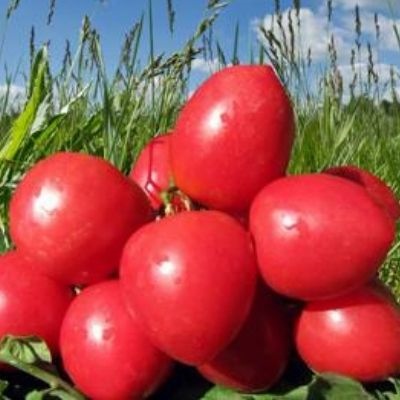
- Category: grade
- Growth type: indeterminate
- Ripening period: late ripening
- Ripening time, days: 130
- Growing conditions: for greenhouses
- Bush size: medium-sized
- Bush height, cm: up to 150
- Bush characteristic: powerful, liana-like
- Ripe fruit color: pink
- Fruit shape: oval
One of the important qualities of tomatoes, which breeders are constantly working to improve, is keeping quality. Today, many varieties have been created that can not lose their presentation and great taste for several months, up to six months. Tomato Lantern Fokina is an excellent choice for those who want to decorate the New Year's table with fresh tomatoes from their own garden.
Breeding history
Fokin's lanterns are a rare domestic variety with an unexplained history of origin. Most likely, it was bred by non-professional tomato breeders and is a nominal amateur. It is not mentioned in the archives of the State Register of Breeding Achievements. Distributed by private tomato growers and seed collectors.
Description of the variety
Fokin's lanterns are medium-sized (up to 150 cm), late-ripening, high-yielding variety with indeterminate liana-like bushes, intended for growing in greenhouses. Produces medium-sized dense pink lined, round-shaped fruits weighing up to 200 grams. Unpretentious, rarely affected by diseases. It is included in the category of long-term storage tomatoes with keeping quality up to 5 months.
The main qualities of the fruit
Small oval tomatoes of the variety are similar to bright pink lanterns: absolutely symmetrical, slightly elongated, with a slightly pointed tip. Their skin is elastic, glossy, does not crack. The raspberry-colored pulp is fleshy, dense, without wateriness.
The main advantage of the variety is the record shelf life of the fruits. The autumn harvest must be sorted out, sifting out the damaged fruits, and the whole and healthy ones must be sorted according to the degree of ripeness. You can store tomatoes in various containers: in glass jars, in layers in boxes (lined with sawdust or paper), in cardboard boxes, in wicker baskets. The main condition is absolute dryness of containers and fruits. Tomatoes should not be washed in any case, but they should be collected from the bushes during the day, when the drops of morning dew have dried.
Taste characteristics
According to gardeners and tasters, Fokin's Lanterns are one of the sweetest varieties in a fairly large group of long-term storage tomatoes. Pink tomatoes have a higher sugar content than ordinary red-fruited tomatoes.
It is advisable to use such tomatoes fresh for food, because in winter and early spring we experience a deficiency of seasonal vegetables and a lack of vitamins. Salads are prepared with the fruits of this variety, stuffed with any fillings (cheese, fish, meat, mushrooms), added to delicious cuts for decoration. But if desired, Fokin's Lanterns can be preserved, the marinade will add spice to their sweet taste.
Ripening and fruiting
Almost all varieties of tomatoes stored for a long time are late-ripening. In the Lanari Fokina variety, a little more than 4 months pass from the first shoots to the appearance of ripe fruits: about 130 days. The growing season of the plant is long: the fruits on the bushes continue to ripen until the beginning of autumn frosts.
Yield
Lanterns of Fokine have a high yield, inherent in most varieties with liana bushes. For them, the usual figures are 6-10 kg per bush.Fruits in the collection are leveled, beautiful, dense. The harvested crop can easily withstand long-distance transportation without damage and loss of presentation.
The timing of planting seedlings and planting in the ground
Tomato Lantern Fokina belongs to greenhouse crops, so sowing work for seedlings can be started early and carried out from the second half of February to early April, depending on the region. Seedlings need to prepare fertile soil, maintain moisture levels and provide good lighting.
When each seedling has a pair of leaves, you should transplant the seedlings into a larger container, or dive each plant into a separate pot (cup).
At about two months of age, the seedlings are planted in a permanent place. A pit is prepared for each bush, adding humus, ash and superphosphate to the soil.

Growing tomato seedlings is an extremely important process, because it largely depends on whether the gardener will be able to harvest at all. All aspects must be taken into account, from seedbed preparation to planting in the ground.
Landing scheme
Indeterminate varieties are placed in a greenhouse in two rows in a checkerboard pattern of 60 x 70 cm.

Growing and care
A powerful tomato bush Lantern Fokin reaches 1.5 m in height, therefore, as it grows, it requires pinching. The plant is led in 1-2 stems and pinched the top. For a liana-shaped bush, it is preferable to tie the stem and brushes to a trellis or net, and not to a single support.
Fokin's lanterns are unpretentious and endure temperature drops and drops. In covered greenhouses, the variety is cultivated in most regions of Russia.




A plant needs different micronutrients at each stage of growth. All fertilizers can be divided into two groups: mineral and organic. Folk remedies are often used: iodine, yeast, bird droppings, eggshells.
It is important to observe the rate and period of feeding. This also applies to folk remedies and organic fertilizers.
Disease and pest resistance
The variety is rarely affected by viral and fungal diseases, it is resistant to rot and leaf spot.
Prevention of late blight includes the following measures:
loosening the soil after watering;
mulching;
good lighting and ventilation;
removal of the lower leaves.
Methods for the prevention and control of insect pests:
compliance with the irrigation regime;
digging up the soil;
disinfection of the greenhouse;
treatment of bushes and soil with biological products.



























































































